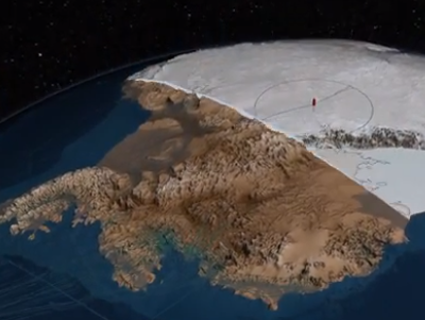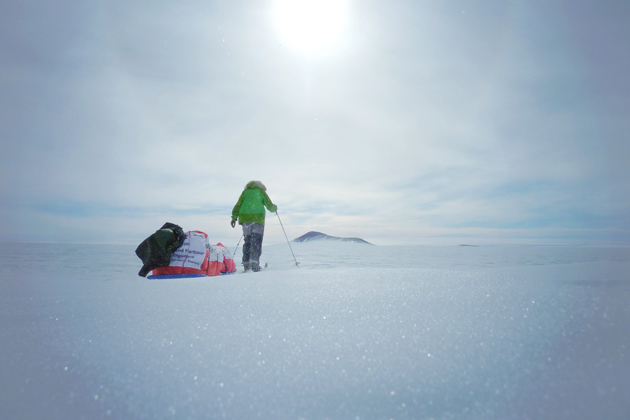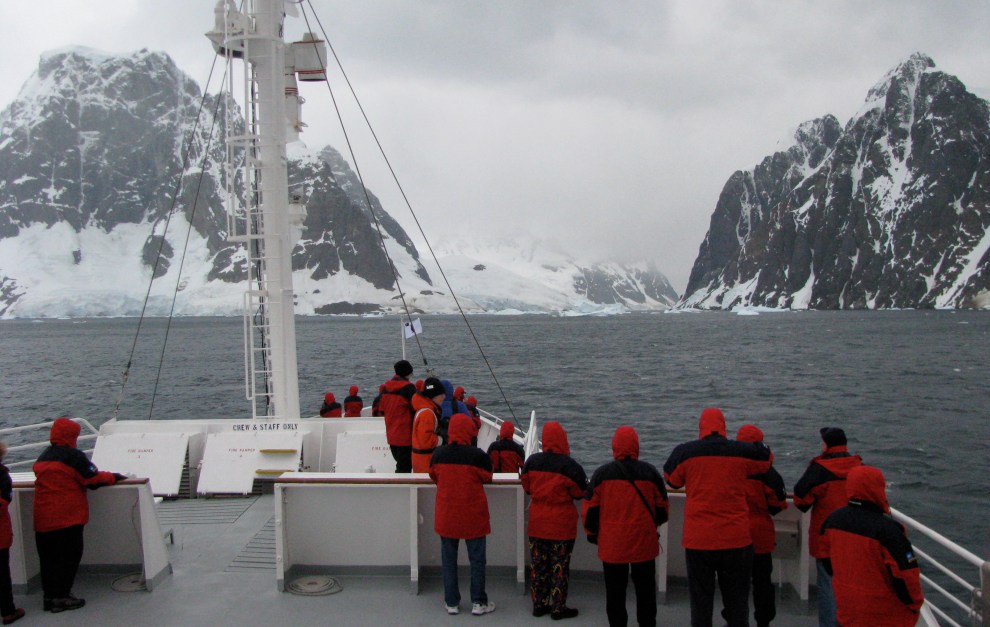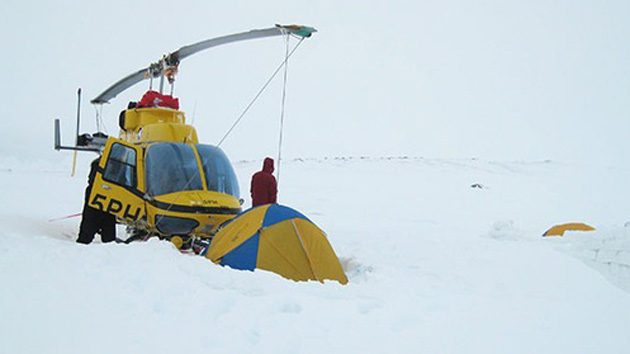
Douglas Fox
This story originally appear in The Atlantic and is reproduced here as part of the Climate Desk collaboration.
The flight should have been routine: a straight shot from Sjögren Glacier on the coast of Antarctica, over an ocean sound crusted with sea ice, back to the ship where we were based, 20 miles east. But as moments passed, a haze of fog and snow flurries closed in on the helicopter. Our pilot, Barry James, glided lower and lower over the sea ice; with no horizon on sight, the ice’s rippled, wind-pocked texture provided his only frame of reference for keeping the helicopter stable in the air. Even this lifeline began to dissolve into milky white, and James wisely chose to land the helo on the only non-white object in sight: a dark swath of stone and sand that had just come into view — the small corner of an island that was otherwise cloaked in glaciers. James spoke into his radio: “Five papa hotel”—the aircraft’s call letters—”this is Barry. I’ve landed. There’s too much snow and not enough visibility to continue.” And so began an unlikely adventure. We expected to wait 15 minutes for weather to improve. Instead, we waited for days.
The helo would become unflyable as icicles encrusted its delicate rotor. Our ship, the 6,000-ton icebreaker Nathaniel B. Palmer would curtail its scientific research as it attempted to reach us. Our experience illustrates the limits of what even massive resources can accomplish in the deep polar regions. It also sheds light on the drama that has unfolded off the coast of East Antarctica as crew members attempted to free the Russian ship Akademik Shokalskiy from the sea ice that trapped it for two weeks. Fifty two tourists and scientists were rescued by helicopter on January 1; but the ship remained wedged in ice with 22 crew on board for another six days before finally getting free earlier today. It represents the latest in a troubling trend: Tourist or fishing vessels getting in over their heads in Antarctica, exacting a heavy toll on already-stretched scientific research assets in the area. The Chinese research icebreaker that helped rescue the Shokalskiy’s passengers also became mired in ice for several days, and the US icebreaker, Polar Star, was dispatched from Australia on January 2 to aid both ships.
Our own adventure began on February 8, 2010. That dim morning I flew from the ship to the edge of Sjögren Glacier, a river of ice several miles across and half a mile thick that pours through a fjord into the ocean. I collected rock samples with Greg Balco, a geologist with the Berkeley Geochronology Center in California who hoped to reconstruct the history of how glaciers in the area have receded since the close of the last ice age. Our return flight to the Palmer was waylaid by the snow storm.
Had James, our pilot, continued toward the ship, he’d have risked not finding it—and being forced to land on dimly lit sea ice with no contrast, no shadows, no visual cues for knowing the height of the helo, its tilt, or even whether the spinning blades might strike the ice. “That’s how you end up dying,” he said.
Thirty minutes after landing on the island, James shut down the helo, secured its blades against the wind with ropes staked tight to the ground, and duct-taped foil blankets over the transmission and airspeed sensors to prevent them from icing over. After eight hours of waiting, we called it a night. I bedded down in a tent next to Balco—my bunk mate on the ship whom I hadn’t slept more than two feet from in the last month.
Morning one: Weather worse, wind picking up. We cut blocks of snow and built walls to shield our tents. We rationed our freeze-dried food to one meal per day. We ventured frequently into the blowing snow to take walks for warmth. Balco found a wooden crate sitting in the snow, filled with jars and cans—Leche Condensada and other items too rusted to read—supplies likely left by an Argentine expedition decades before.

Morning two: Three postage stamp-sized squares of chocolate for breakfast, a packet of freeze-dried chili for lunch. Icicles two feet long hung from the helo. The wind shifted directions, prompting us to move our snow-block walls. We passed around a battered Louis L’Amour novel and caught up on sleep—easy in our hypo-caloric stupor.
That afternoon, four brown birds drifted down through the gauzy white and alighted near our camp—sea birds called skuas. They picked at a saucer-sized piece of foil—a wind-shredded remnant of the blankets that James had taped on the helo. Finding it inedible, the birds departed—perfectly at home in this place, even if we were not.
It seemed plausible that we might wait for a week before anyone could fetch us. Food would run out, but at least we’d have plenty of fuel for melting snow into drinking water. One thing, however, worried me.
Among our 100 pounds of survival gear, my worry hinged on something weighing no more than an ounce or two: the rough-textured strips used for striking matches. The wet melting snow and condensation of water was gradually rendering them unusable. If we couldn’t light a stove, we couldn’t drink.
“Washington is aware of your situation,” someone on the Palmer told us during a radio check-in. Those words, in the right context, are surprisingly funny.
The wind whined. The helo shuddered. The ropes that held it to the ground vibrated like banjo strings. During lulls, a low rumble reverberated through the air, rising and falling—the diesel engines of the Palmer, six miles away, repeatedly backing up and ramming the ice in an attempt to reach us. Doing so almost certainly involved some risk. Only a few days before, the Palmer itself had been trapped in ice.
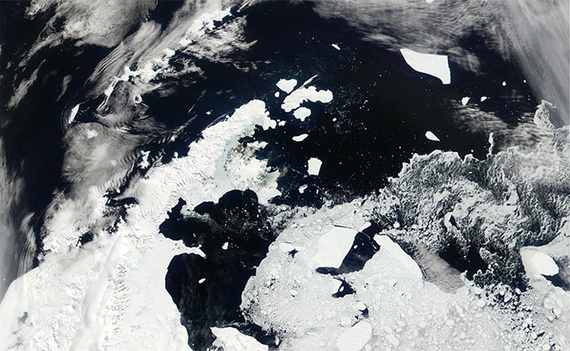
People sometimes refer to the Antarctic Peninsula, where we were sailing, as the “banana belt of Antarctica”—the warmest, wettest, furthest-north part of the continent. But subtle dangers inhabit this area. The Weddell Sea, on the east side of the Peninsula, contains a flotilla of sea ice the size of France, composed of thousands of fragments, or floes, many smaller than half a mile across. A circling ocean current called the Weddell Gyre pushes those ice floes against the Peninsula—compressing them into the equivalent of particle board—making the area impassable even to icebreakers much of the time. This is the ice that cornered and crushed Ernest Shackleton’s ship, the Endurance, in 1915. People on board the Palmer hoped to penetrate this region in 2010.
Satellite images beamed to the ship showed unusually heavy ice. “I’ve seen bad ice,” said Vladimir Repin, the Palmer‘s ice pilot: a tall, taciturn, white-bearded Russian who began his 35-year career in the icy Siberian port of Murmansk. “But this is real heavy ice,” he said, “some of the worst I’ve ever seen.” The satellite images nonetheless offered a ray of hope: a sliver of ice-free water, perhaps half a mile wide, that provided a potential southward path along the inland edge of the ice. With luck, Westerly summer winds would push that France-sized agglomeration of ice further from land—widening the needle that the Palmer would have to thread. Unfortunately, it didn’t work out. As the ship pushed through a crack in the ice on the afternoon of January 30, the winds failed; the ice snapped shut.
The ship ground to a halt even as its engines gushed 13,000 horsepower of thrust. Up on the bridge, the lead scientists conferred with the ship’s captain, Joseph Borkowski III, a burly man, white-goatied, toothpick in mouth, whose rangy Louisiana accent seemed out of place in this polar wasteland. “There’s a lot of pressure on the ice,” he said. “You see those ridges over there and there?” He motioned to miniature mountain ranges of crushed ice that had risen where the floes pressed together like continental plates. “It isn’t safe here.”
Ice gradually nosed its way under the starboard side of the Palmer, causing the ship to tilt. The 60-foot ice-free corridor that the ship had plowed in its wake closed into a pressure ridge four feet high. Borkowski, at the controls, looked on with a mixture of resignation and disgust. “We can’t go forward,” he grumbled to one on in particular. “Can’t go fuckin’ back.”
A GPS monitor on the bridge traced the Palmer’s Ouija-board meander as it drifted northeast with the ice and the currents, 150 yards per hour. The ship leaned further to the right. For 70 people on board, a tilted floor became the new normal.
The pressure on the ice lifted after just 24 hours, allowing the ship to escape. Borkowski and his mates nudged the ship from its frozen straight-jacket: a two-hour process that involved filling two tanks on the left and right side of the bow with 200,000 gallons of water, then pumping the water back and forth to rock the ship. A helicopter launched from the ship with Repin, the ice pilot, on board. He and Captain Borkowski talked on the radio as he scouted a path out of the dangerous ice.
“See where we are now?” Repin’s voice crackled over the radio. “Follow the helicopter.”
“I see you, Val,” answered Borkowski. He zigzagged the ship through gaps in the ice in a manner more befitting a dune buggy than a 308-foot icebreaker. The Palmer rocked back and forth as it rode over the edges of ice floes. Now and then, a block of ice the size of a city bus bobbed up like a cork from beneath a floe—a testament to the strength of the currents: when the floes slammed shut the day before, the 100-ton ice block had been shoved underneath like a Styrofoam cup caught in a logjam.
“Turn to the left now,” said Repin over the radio. “Where the helicopter is, there’s broken ice.” The ship emerged into a narrow corridor of open water running along the edge of a tabular ice berg. Borkowski steered along the edge of this smallish berg, and its immense size became clear. For half a mile the berg’s vertical cliff towered over the top deck of the Palmer.
After half a day, the ship took shelter between two islands that sheltered it from the shifting pressures of the Weddell Sea.
This was a minor stranding in the overall scheme of things—the Palmer spent 26 continuous days locked in ice in 2001—but it captures the challenges that even the world’s most powerful ships face in the polar oceans.
An icebreaker can only go where the ice will allow it to go. The Palmer’s attempt to reach us on the island was ultimately abandoned.
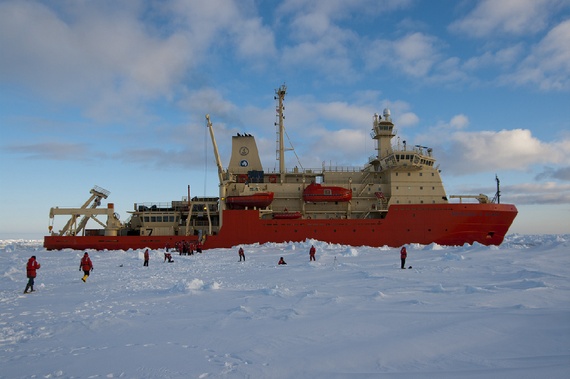
At 5:00 a.m., our third morning on the island, I awoke to utter quiet. The storm had almost certainly abated.
I unzipped a top corner of the tent door and shoveled out through three feet of snow. I poked my head out: Blowing snow, and worst visibility yet. The snow drifting around our tent had simply muffled the sound of the wind.
Amazingly, only 10 hours later, we would be rescued. Chris Dean, the Palmer’s other helo pilot, squeezed his aircraft through a transient hole in the clouds to reach us—a frenzied moment of slinging bags into the helo—then we lifted off through a swirl of mist that shifted by the second, leaving our tents and iced-covered aircraft behind to be retrieved another day.
Unlike the Palmer, the Shokalskiy is merely an ice-strengthened ship, with less ability to push through ice. It will take time to learn whether this ship was truly suited for the expedition at hand—or whether other preventable factors, such as lapses in judgment, might also have contributed to the ship’s stranding. What’s already known is that the rescue of the passengers and ship will impose significant costs on the Australian, Chinese, and US polar programs (each of which sent icebreakers to aid the Shokalskiy). Depending on oil prices, even a medium-sized icebreaker like the Palmer can consume upwards of $20,000 of fuel per day. Such monetary costs can be reimbursed. What cannot be reimbursed is the time that these ships lost in the rescue effort.
The schedules of polar icebreakers are typically set a year or more in advance. The maximum amount of science is packed into each cruise—be it collection of deep-ocean water samples, sonar mapping of the seafloor, or deployment of instruments (anchored to the seafloor) that will measure ocean currents and glacial melt long after the ship departs. A day of data collection lost on one of these few ice-capable research ships is a day that will never be replaced.
I’m grateful to our pilot, James, for landing on the island on February 8, 2010. It was the right decision: Despite worries about our continued ability to light stoves and generate drinking water, our situation never approached life-threatening. Those four days will always rank among the most memorable of my life. But even at the time I found it upsetting to know that the Palmer was curtailing its own work to try and reach us.
Strandings and delays are an inevitable part of working in the poles. The US Antarctic Program manages to deal with these contingencies. But there exists an inherent tension between Antarctica’s thin-stretched scientific infrastructure and the tourism and adventure expeditions that increasingly venture there. When a private plane landed at the US research base McMurdo Station in 2003 needing to buy 110 gallons fuel, US officials declined to sell it, fearing that other private expeditions would expect access to fuel that is shipped into McMurdo at great cost, through an open-water path that is cleared each year by an icebreaker. When supplies including food and thousands of gallons of fuel are cached at remote locations on the ice sheet for future research expeditions, the GPS coordinates of those caches are kept under wraps, perhaps in part for fear that these supplies could be pilfered by private parties in dire need.
The challenges of operating in Antarctica, as experienced during the Palmer’s voyage in 2010, will not diminish in the foreseeable future. The increasing allure of Antarctica as a travel destination may only exacerbate them.
